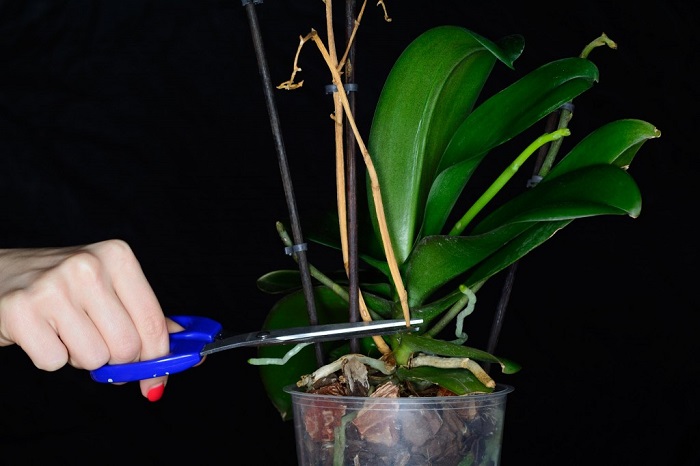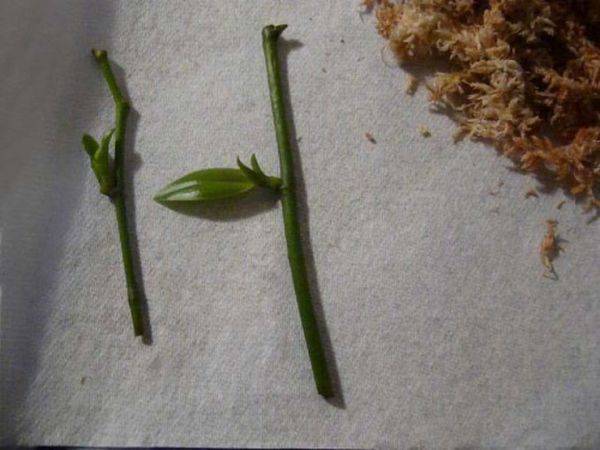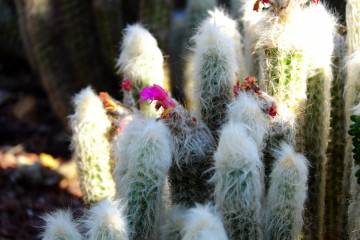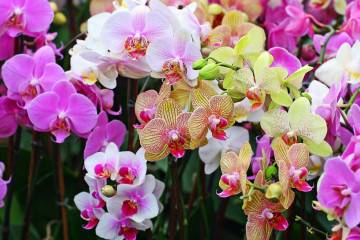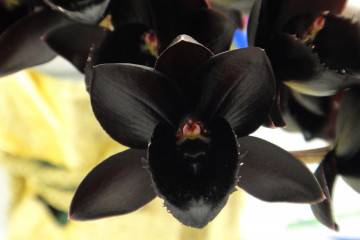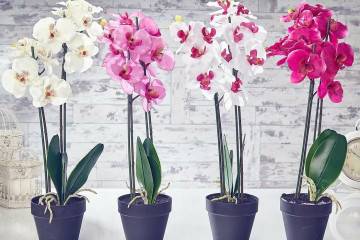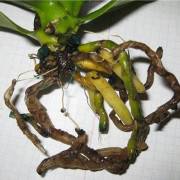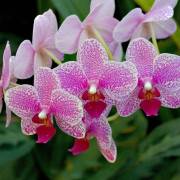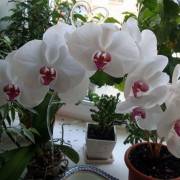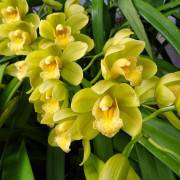The orchid has faded what to do with the arrow: care and pruning options
Content:
In stores, the orchid is sold with beautiful lush flowers. With its bright and unusual petals, the plant will delight for a couple of months, and then the question arises - the orchid has faded, what to do with the arrow. whether you need to remove it or wait until flowers appear on it again.
Conditions for the need for trimming
An orchid arrow left after flowering does not always require pruning. You need to pay attention to its condition and color. If it is green, you can leave it, there is a chance that a bud will appear on it.
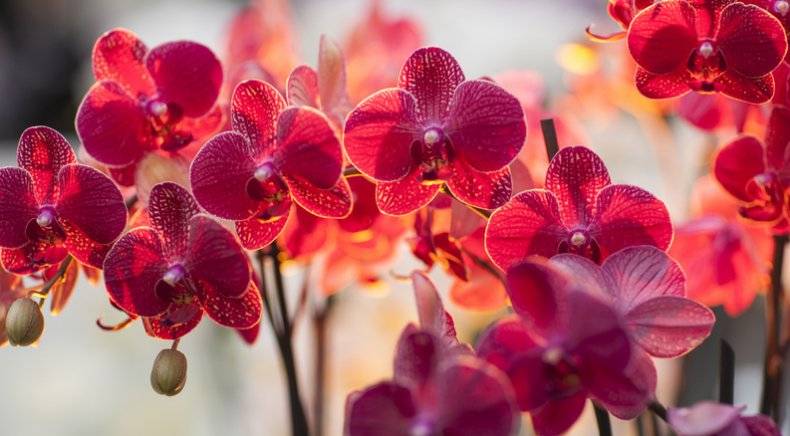
Orchid is one of the most demanded flowers, they love it for the beauty and tenderness of the petals.
Yellow leaves
You need to remove the arrow if the leaves of the flower have turned yellow. This sign indicates that the plant has been ill and will not appear on it without removing the damaged parts of the buds. Other reasons why a plant may turn yellow:
- natural aging process;
- insufficient lighting;
- excessive moisture in the soil;
- burns from direct sunlight;
- improper watering - lack of water or too much water;
- excess or lack of nutrients.
In addition to pruning, as the main measure to restore the health of a flower, it is necessary to normalize its care.
Depletion
Due to the fact that the orchid blooms for an extended period, it can be depleted, especially if it does not receive additional nourishment. The plant needs to accumulate a new supply of nutrients in order to continue to actively develop and bloom regularly.
When depleted, the peduncle is cut off below the level of all the buds. A stump is left no more than 2 cm high. If you do not follow all the rules and cut off the stem above at least one bud, a new arrow with buds will appear very soon. This will lead to the final depletion of the flower and it may die.
Dormant period
Without rest during the dormant period, the flower will not be able to continue flowering. After the orchid fades, there is no need to rush to remove the arrow from it. This is only done if it is damaged or dries out. After a short time after the withering of the first buds, the orchid can bloom again profusely. This is typical for the Phalaenopsis variety.
Drying the flower
The dried shoot must be removed. It is cut at a distance of 2 cm from the rosette of leaves.
Trimming the stalk to stimulate the new arrow
For the orchid to have the strength to re-release the buds, it needs to be stimulated. The optimal time for pruning is a dormant period when there are no flowers or new buds. This period begins approximately from the beginning of October to the last days of November.
Stimulating pruning must be carried out in a timely manner, otherwise buds will appear on the orchids, due to which the flower will greatly weaken and any manipulations can only harm it.
Pruning rules
Having decided on the state of the plant what to do with the orchid after flowering, you need to prune correctly:
- Only a disinfected instrument is used. It can be treated with antiseptic solutions or kept in boiling water.
- The arrowhead is shortened by 2/3 of its original length. The part that remains will soon be able to sprout new buds.
- Pruning is carried out at a distance of 2 to 2.5 cm above the sleeping bud. If you do not follow this rule, the kidney will dry out.
The time of the appearance of a new peduncle
In order for the plant to shoot new arrows, and buds appear on them, you need to know how to care for the orchid after it has faded:
- Water the flower no more than once a week with a little water. If the room is cool and humid enough, watering the orchid is not at all necessary.
- The optimum temperature during the day is from +22 to +24, at night the orchid will be comfortable at + 16-180 degrees.
- In the fall, the flower must be kept illuminated for at least 12 hours. If there is not enough daylight hours, fluorescent lamps are additionally used.
After removing the old arrow, a new one will appear no earlier than in 2-3 months.
The temperature difference is a prerequisite for the appearance of a new arrow with buds. If the temperature is always at the same level, this will stimulate active growth of the leaves. There will be few buds or they will not appear at all. To ensure the temperature drop, the orchid can be taken out at night on the balcony or, if possible, on the street.
Cropping an arrow for propagation
When the flower has passed a period of activity, what to do with the orchid at home after flowering is of interest to many. In order not to simply throw out the removed part, it can be used as a seed in order to propagate the plant.
Cutting technology
For propagation of an orchid, the cuttings method is used. After flowering, the arrow must be cut off when it is still green and there are dormant buds on it:
- pruning is carried out to the base of the flower;
- the arrow is cut into several parts, the length of each should be about 3-4 cm;
After cutting, the cut site must be treated with coal dust or watered with liquid wax. You can make coal dust yourself by crushing an activated carbon tablet.
Conditions for the appearance of a new baby
There are two ways to care for cuttings:
- dip them in sphagnum moss or in moist soil saturated with nutrients;
- keep cuttings in water.
Regardless of which method is chosen, the cuttings need to create greenhouse conditions. For this, the container with them is covered with a film, sufficient lighting is provided. The temperature is about +25 degrees, the humidity level is 70%.
Babies will begin to appear on the cuttings in about 1-1.5 months.
Before placing the cuttings in water or moss, they need to be soaked in a growth stimulator for several hours.
Further care of the flower at home
Every gardener should know how to care for an orchid after its flowering, if he wants to observe its beautiful and long-lasting flowering again. Basic rules and recommendations:
- Watering. Its frequency and amount of water is reduced. But at the same time, the substrate should not be allowed to dry out. The ground should always be slightly moistened. Dried soil is not able to provide the roots with the necessary nutrient supply.
- Humidity. The natural habitat of the flower is the tropics, where it is hot and high humidity. These are the ideal conditions for the plant to bloom abundantly and frequently. Humidity for indoor orchids should be between 50% and 80%. To provide the necessary moisture, the plant must be sprayed regularly.
- Lighting. Orchids are sun-loving plants, but the light should be diffused. Direct sunlight on leaves will cause burns on them. Recommended locations for flower pots are east or southeast.
- Preventive measures to prevent disease. The easiest way to cure the disease is at an early stage of its development, when it is possible to restore the state of the orchid. The flower should be regularly inspected and, if the first signs of any deviations are found, appropriate measures should be taken to eliminate them.
When the orchid has faded, what to do next is still a question for novice florists. You should know that not only the arrow is subject to removal, but also the damaged parts of the root system. If there is rot or moss on the roots, they must be carefully removed.
If the root system has grown strongly, it is recommended to divide it into several parts and use it as planting material.
When the orchid fades, its arrow must be removed. This measure will stimulate the re-growth of the new arrow, and on it the appearance of fresh, strong buds. After pruning, looking after the flower is easy. At this time, watering is reduced, the correct temperature regime and sufficient, diffused lighting are provided. If you take care of the orchid correctly, it will delight with abundant and frequent flowering.
